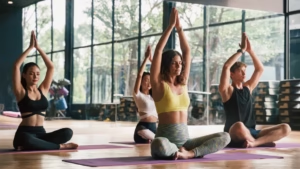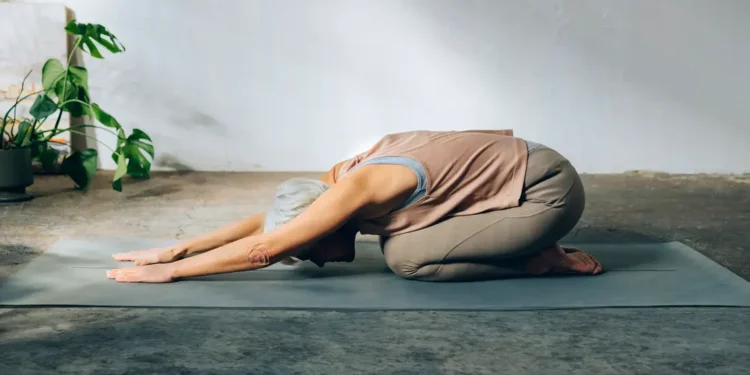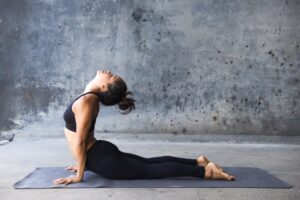Yoga is more than just a physical workout—it’s a mindful practice that integrates movement, breath, and meditation. This powerful combination has been shown to:
- Release Muscle Tension
Stress activates the sympathetic nervous system (commonly known as the “fight or flight” response), which often results in muscle tightness and chronic pain. Yoga calms this system while gently stretching and strengthening the body, helping to ease discomfort associated with:
- Lower back pain
- Neck and shoulder tension
- Arthritis
- Fibromyalgia
- Activate the Body’s Relaxation Response
Through deep breathing and focused awareness, yoga stimulates the parasympathetic nervous system—the “rest and digest” mode. This leads to slower breathing, reduced heart rate, relaxed muscles, and the release of mood-enhancing chemicals such as endorphins and GABA, which help regulate anxiety and emotional balance.
- Reduce Inflammation
Prolonged mental stress has been linked to chronic inflammation and accelerated cellular aging—factors that increase the risk of conditions like diabetes, osteoporosis, and neurodegenerative diseases. Research indicates that yoga may lower cortisol levels, helping to minimize inflammation and slow biological aging.
Top Yoga Poses for Stress Relief
Whether you prefer slow-paced hatha yoga or dynamic vinyasa flows, certain poses are particularly effective for calming the nervous system and relieving stress. Here are six foundational poses to incorporate into your routine:
- Legs-Up-the-Wall Pose (Viparita Karani): A gentle inversion that encourages circulation and deep relaxation.
How to do it:
- Sit sideways next to a wall, knees bent.
- Swing your legs up the wall as you lie back.
- Position your back flat on the floor and your hips close to the wall.
- Rest your arms comfortably and breathe deeply for up to 3 minutes.
- Reclined Butterfly Pose (Supta Baddha Konasana): A restorative hip opener that promotes calm and releases stored tension.
How to do it:
- Lie on your back, feet flat and knees bent.
- Let your knees fall open to the sides, bringing the soles of your feet together.
- Relax your arms and breathe deeply for several minutes.
- Supine Twist (Supta Matsyendrasana): A gentle spinal twist that aids digestion and soothes the back.
How to do it:
- Lie on your back, knees bent.
- Drop your knees to one side while turning your head to the opposite side.
- Extend your arms in a “T” position and breathe for a few rounds before switching sides.
- Seated Forward Bend (Paschimottanasana): A calming stretch that soothes the nervous system and promotes introspection.
How to do it:
- Sit with legs extended and spine upright.
- Inhale to lift your arms, then exhale as you hinge at the hips and reach toward your feet.
- Modify with a yoga strap if needed, and breathe deeply in the pose.
- Bridge Pose (Setu Bandhasana): An energizing chest opener that builds strength and relieves stress.
How to do it:
- Lie on your back with knees bent and feet hip-width apart.
- Press into your feet and hands to lift your hips.
- Clasp your hands beneath your back or leave them grounded.
- Hold for several breaths, then lower gently.
- Cat-Cow Stretch (Marjaryasana-Bitilasana): A rhythmic flow that connects breath and movement, easing spinal tension.
How to do it:
- Begin on all fours with a neutral spine.
- Inhale to arch your back and lift your gaze (cow).
- Exhale to round your spine and tuck your chin (cat).
- Continue for several cycles, syncing breath with movement.

Maximizing the Benefits: Tips for Practicing Yoga for Stress Relief
To truly harness yoga’s stress-relieving potential, keep these mindful strategies in mind:
- Stay Present: Treat your practice as a moving meditation. If your thoughts wander, gently return your focus to your breath and movement.
- Breathe Intentionally: Breath control, or pranayama, is a cornerstone of yoga. Try techniques such as alternate nostril breathing or breath retention to deepen your practice.
- Set Intentions: Approach yoga with purpose—whether that’s finding peace, cultivating gratitude, or simply connecting with your body.
- Be Consistent: Aim for 2 to 4 sessions per week to experience noticeable improvements in mood, sleep, and overall stress levels.









